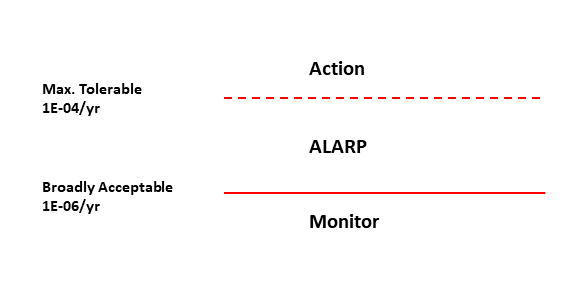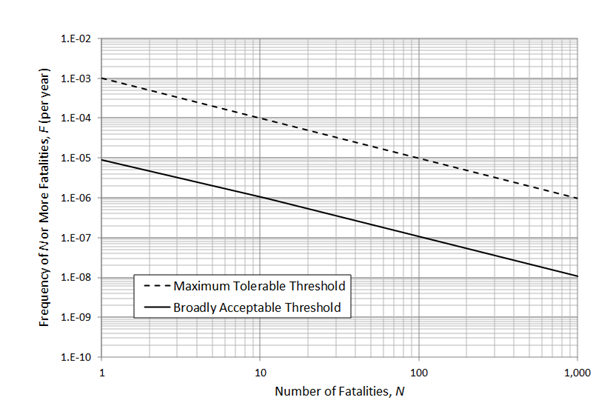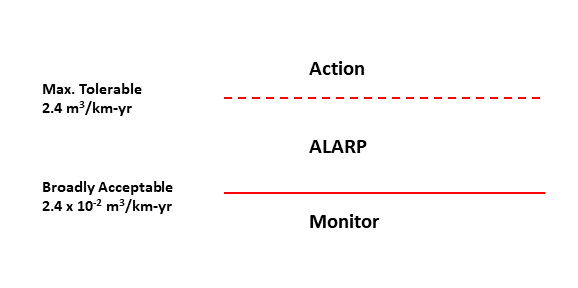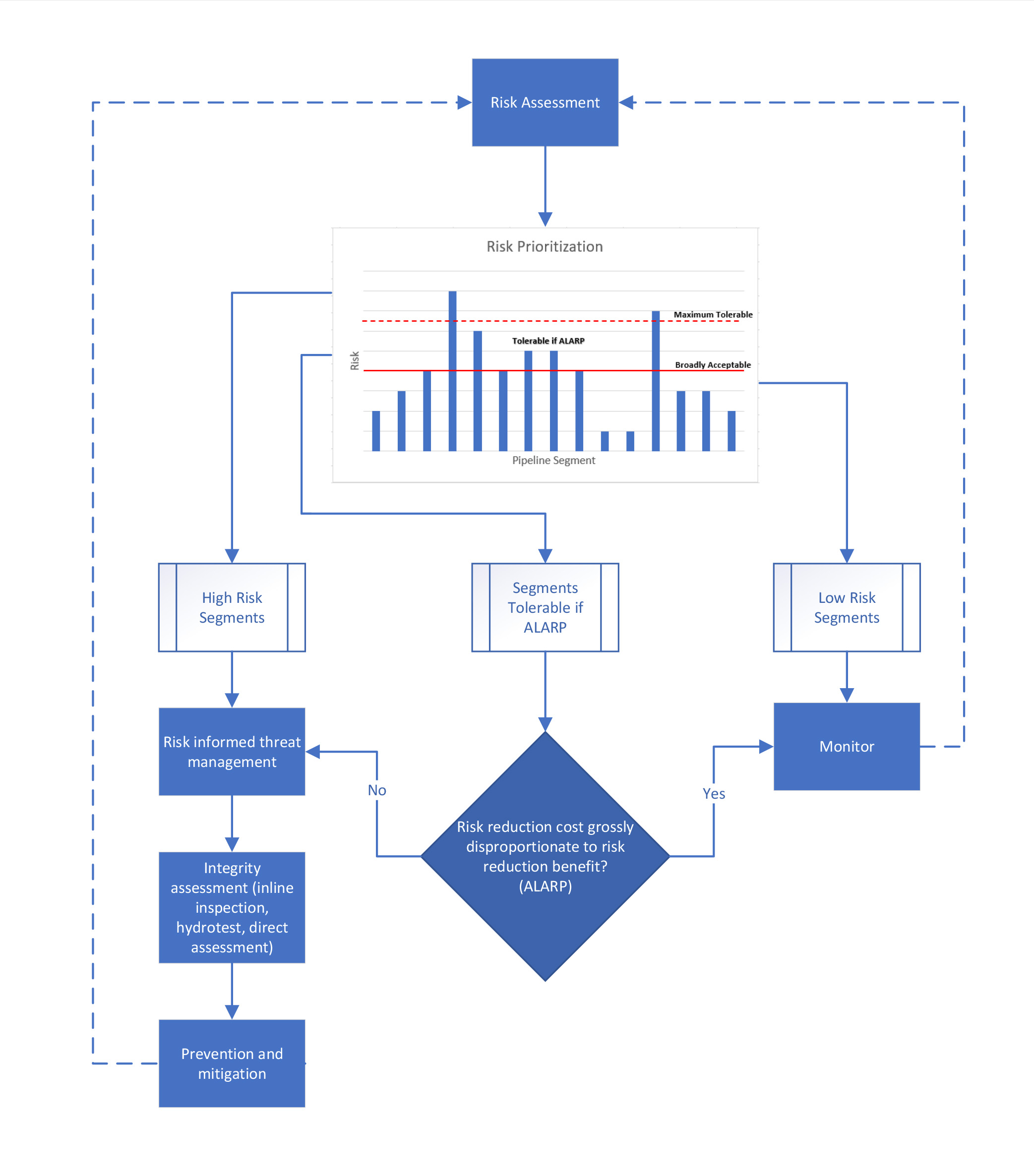Canadian Standards Association (CSA) Z662:23 Proposed Updates: Pipeline Risk Assessment (Annex B)
What are the main updates proposed for the CSA Z662:23 Standard as it pertains to pipeline risk assessment?
Dynamic Risk has participated in the CSA Z662 Risk Management Task Force which has developed proposed changes to Annex B (informative): “Guidelines for risk assessment of pipeline systems” to be incorporated in the CSA Z662:23 Standard. Highlights of these proposed changes are as follows:
- Update to Risk Management Process framework (more detail around risk evaluation and risk control components)
- Additional guidance on risk measures and risk output formats
- Incorporation of risk acceptance criteria and the “as low as reasonably practicable” (ALARP) principle as part of risk evaluation
- General guidance on developing one’s own risk acceptance criteria
- Guidance on specific quantitative Safety Risk (Societal and Individual Risk) acceptance criteria
- Guidance on specific quantitative Environmental Risk acceptance criteria
Key updates to highlight from those listed above are the inclusion of specific quantitative Safety Risk and Environmental Risk acceptance guidelines. The Safety Risk criteria have a basis in national and international precedent and previous background work for CSA Z662 Annexes C and O. The Environmental Risk criteria have a basis in previous background work for CSA Z622 Annexes C and O including industry environmental impact modeling references. The proposed risk acceptance criteria are as follows:
Guidance on safety risk (LoF x CoF) acceptance criteria:
- Individual risk: broadly acceptable individual risk threshold is 1 x 10-6/yr and the maximum tolerable risk threshold is 1 x 10-4/yr as shown in Figure 1.

Figure 1 – Schematic of CSA Z662:23 Proposed Individual Risk Thresholds
- Societal risk: the broadly acceptable and maximum tolerable thresholds are as established on an F-N curve as shown in Figure 2.

Figure 2 – Schematic of CSA Z662:23 Proposed Figure B.7 Societal Risk Thresholds (Based on 1 km of Pipeline)
Guidance on environmental risk (LoF x CoF) acceptance criteria:
- Broadly acceptable environmental risk threshold is 2.4 x 10-2 m3/km-yr and the maximum tolerable risk threshold is 2.4 m3/km-yr (impact-adjusted release volume) as shown in Figure 3.

Figure 3 – Schematic of CSA Z662:23 Proposed Environmental Risk Thresholds
How does Dynamic Risk support pipeline operators to address these updates?
QRA supports integrity management activities and prioritizations vis-à-vis an established risk-informed decision-making process. When QRAs are employed in application with appropriate acceptance criteria that are standardized and widely recognized by industry (i.e., such as those proposed for CSA Z662:23 Annex B), this provides a pathway forward for demonstrating pipeline safety levels to stakeholders in the context of both pipeline risk assessments and engineering assessments. With an aim of eliminating high consequence incidents, Integrity Management teams require a meaningful basis and target for prioritizing effective preventive/mitigative programs and for supporting overall decision-making as outlined in the QRA example in Figure 2.

Figure 4 – Integration of QRA into Integrity Management
How does Dynamic Risk support pipeline operators to address the CSA Z662:23 risk assessment updates?
Dynamic Risk supports the alignment of our clients’ risk programs and philosophies with risk acceptance criteria. We bring the required expertise and rigor to risk modeling and risk assessment to ensure the approaches provide for effective decision-making through comparison to appropriate risk acceptance criteria.
Our team of technical experts will be actively involved in the upcoming 2023 Banff Pipeline Workshop risk & reliability tutorials and sessions including specific panels on the CSA Z662:23 risk assessment updates. We are also actively working collaboratively with major US gas transmission operators as part of an industry Consortium to advance the use of QRAs.
Our software applications, IRAS RiskAnalyst coupled with our Author risk modeling algorithm tool, provide Integrity Management teams the ability to understand and manage the various changes impacting pipeline risk using a variety of approaches with quantitative risk measures. Users can demonstrate an optimized plan through systematic testing, scenario models and cost-benefit analysis to continuously refine and improve their pipeline risk assessment program. By advancing the use of QRA, operators can make informed and confident decisions from their risk assessments and develop effective and targeted preventive/mitigative plans.
About the Author:
Dan Williams, Principal Consultant / Client Lead, Strategic Business

Dan is a licensed professional engineer with a background in Materials Engineering and has over 30 years combined experience in pipe and tube manufacturing, pipeline integrity and pipeline risk management. Dan is a Principal Consultant / Client Lead at Dynamic Risk where he is responsible for providing technical leadership in pipeline engineering assessment and risk assessment solutions. This includes pipeline risk modeling, conducting threat-based engineering assessments, assessing in-line inspection results and tool performance validation and reporting on engineering and risk assessment results for both liquids and gas transmission pipeline operators in Canada and the United States. This experience has also included providing regulatory support to operators in these areas. Dan is a member of the CSA Z662 Risk Management Task Force which has drafted proposed changes for Annex B in the 2023 Standard.


